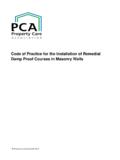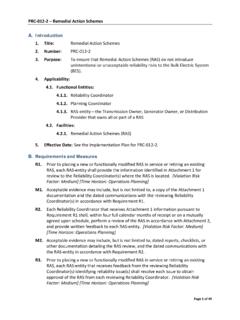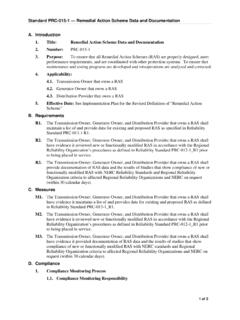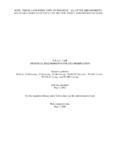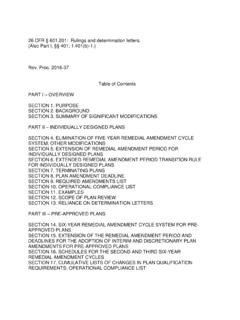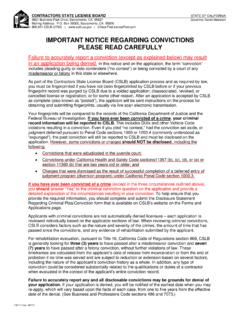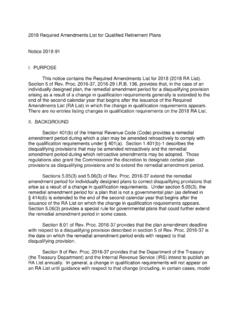Transcription of Casting Defects Analysis in Foundry and Their Remedial ...
1 IOSR Journal of Mechanical and Civil Engineering (IOSR-JMCE) e-ISSN: 2278-1684,p-ISSN: 2320-334X, Volume 12, Issue 6 Ver. I (Nov. - Dec. 2015), PP 43-54 DOI: 43 | Page Casting Defects Analysis in Foundry and Their Remedial Measures with Industrial Case Studies Avinash Juriani1 1( Scholar, Department of Mechanical Engineering, Indian School of Mines, Dhanbad, Jharkhand, India) Abstract: In this current scenario of globalization, foundries play a key role for manufacturing industries as they are the major source of castings. As a key industry a Foundry s performance should be effectively high in terms of production with minimum number of rejections.
2 Castings are the major inputs for most industrial products hence Foundry industry is most indispensable. Casting is an integrated process considered as an artwork with experienced professionals for high quality yield, even then in highly controlled environment Defects are dominant to take place leading to rejections, contrary to rejections a Foundry s key attempt is to satisfy the demands neglecting quality levels. The challenges of Casting Defects are to be identified and minimized for effective castings. This study provides an intense knowledge of critical Casting Defects and Their root cause Analysis . In this paper efforts are made to achieve technically feasible remedies for minimizing several Casting Defects and improving the quality of castings which will serve as control measures for quality control professionals with zero defect concepts.
3 Keywords: Casting Defects , Cause and Effect Diagram, Centrifugal Casting , Defects Analysis . I. Introduction Defects formation in castings is one of the most vexed topics of Foundry industries. Foundry industries mostly rely on different process parameters to control such Defects ensuring high efficacy of Casting with an optimum yield hence controlling of such parameters becomes necessary by sound knowledge of possible causes, for this the probable Defects should be analyzed and Their root causes have to be studied. This paper brings out the industrial case study of castings having prominent Defects . The work was carried out based on production trials. An attempt has been made to analyze the critical Defects and possible Remedial measures are suggested for cast masters to have a sound knowledge about such Defects with an aim to minimize rejections rates.
4 The data was collected to take decisive action for quality improvement with reduced rejection in castings. II. Methodology Cause and Effect diagram is a powerful tool that aids in determining the control factors on quality output. The data was analyzed using Ishikawa Cause and Effect Diagram. Ishikawa Cause and Effect Diagram Casting Defects Analysis In Foundry And Their Remedial Measures With Industrial Case Studies DOI: 44 | Page III. Casting Defects The major Casting Defects are classified as follows: Blowhole Blowhole is a type of Casting defect mostly prevalent in castings, further divided into pin holes, endogenous and exogenous blowholes.
5 Entrapment of air resulting due to pouring of liquid metal takes the form of rounded contours or spherical cavities. Surface blows or inter granular cavities appear in cope of the mould. Pinholes result when the hydrogen present in liquid metal evolves due to less solubility during solidification resulting in triangular appearances, prevalent mostly in thinner castings which are revealed after machining. Case Study Sheave of Grade 270-540 IS1030 undertaken for study showed blowholes on groove edges. Causes High moisture on chills. Low permeability of sand. Improper sand mixing. Inadequate vents. Use of undried coatings. High turbulence during filling. High bentonite content. Excessive Gas Entrapment.
6 Liquid metal not properly degassed. High binder content. Blowhole Remedial Measures Avoid over ramming of sand. Use dry chills only. Optimum pouring temperature at1585 degree centigrade for mild steel. Avoid using fine sand grains. Provision of adequate venting. Use dried and properly dressed cores. Reduce binder and additives. Control of Aluminum level. Increase runner height for increased static pressure. Adjust carbon equivalent value. Use water based zircon coatings. Casting Defects Analysis In Foundry And Their Remedial Measures With Industrial Case Studies DOI: 45 | Page Vent Holes and Riser Placing Shrinkage Shrinkage is a type of Casting defect resulting due to formation of shrinkage cavity as such due to lack of design and insufficient feed metal.
7 Shrinkage results due to formation of a closed loop at a specific point during solidification which creates a cavity because of absence of feed of molten metal. Shrinkage can be classified into three types as open (macro porosity), closed (internal/blind shrinkage) and axial shrinkage. Open shrinkage appear on the exterior of Casting surface resulting due to volume contraction from liquid to solid state. These are visualized as shallow cavities on Casting surface. Closed Shrinkage results due to dense network of dendritic crystals which restricts void feeding of thick sections. Axial shrinkage is a result of long freezing time at the centerline of Casting due to high pouring temperature. Case Study Bottom bearing housing of Grade EN-9 alloy undertaken for study showed internal shrinkage defect towards the centerline.
8 Causes Unevenly dried sand with low compressive strength. Mould wall shift due to high metal pressure. Chills not placed properly. Sudden change in thickness of sections. Too many sharp internal corners causing hot-spots isolation. Excessive Ferro Silicate use during metal charging. Shrinkage Remedial Measures Dry mould using CO2 gas for at least 60 seconds for high rigidity. Use of chills at correct position to for directional solidification. Feeding of sharp corners to avoid hot spots. Riser to be properly located. Use of inoculants. Casting Defects Analysis In Foundry And Their Remedial Measures With Industrial Case Studies DOI: 46 | Page Chills Placing at Ends Hot Tears/Cracks Hot tears are predominant due to imbalance in temperature caused during solidification.
9 These appear to be sharp and broken jagged lines at the edges of Casting . Case Study Bottom Chock of Grade EN-9 alloy undertaken for study showed hot tear near thick sections. Causes Use of coarse size sand grains. Mould disturbance before complete solidification. Imperfect riser location. Abrupt changes to be avoided which increase internal stress High binder and ramming density Hydrogen content too high Low amount of eutectic cells at grain boundary Excess amount of sulphur/phosphorus present Hot Tears Remedial Measures Sufficient cooling of mould to be done. Avoid sharp turns/corners. Provision of draft during removal. Deoxidize to kill sulphur/phosphorus present. Use inoculants mixture of Mn/Si/Mg to reduce sulphur/phosphorus content.
10 Use of fine sand grains. Add coal dust to increase eutectic cells during solidification. Casting Defects Analysis In Foundry And Their Remedial Measures With Industrial Case Studies DOI: 47 | Page Smooth Corners with Zirconite Paint Lamination defect Lamination is a defect mostly occurring in centrifugally casted pipes especially stainless steel pipes visualized as layer of pipes separated from its adjacent layer appearing as a laminated layer protruding from the pipe. Case Study Centrifugally Casted Pipe of Grade SS HK40undertaken for study showed lamination defect protruding from pipe periphery.










